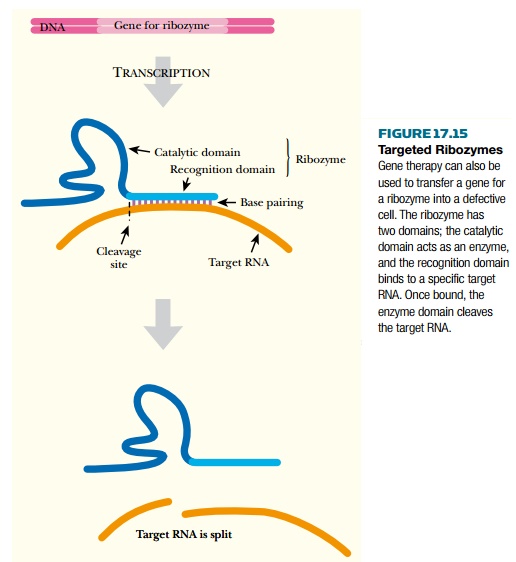Chapter: Biotechnology Applying the Genetic Revolution: Gene Therapy
Ribozymes in Gene Therapy
RIBOZYMES
IN GENE THERAPY
RNA molecules with catalytic
ability are known as ribozymes. Some ribozymes act by cleaving other RNA
molecules. Such ribozymes have catalytic domains that carry out the reaction
fused to domains that recognize the substrate RNA by base pairing (Fig. 17.15).
If the sequence of the substrate recognition domain is changed, the ribozyme
will recognize a different target RNA molecule. Thus ribozymes may be
engineered to recognize and destroy any target messenger RNA molecule. So far
this use of ribozymes is still in the experimental phase. In practice, a vector
carrying a gene encoding the ribozyme would presumably be used for delivery to
the target cell. Transcription of this gene would result in production of the
ribozyme RNA. The ribozyme would then bind and cleave the target mRNA.

All naturally occurring
nucleic acid enzymes are made of RNA. However, there is no chemical reason why
DNA cannot act catalytically. Indeed, deoxyribozymes may be synthesized
artificially, using sequences equivalent to those of RNA ribozymes. The
DNAzymes are less easily degraded and may be manufactured in multiple copies by
a PCR-based technique. Most DNAzymes presently under investigation are targeted
at cancer cells or infectious microorganisms.
Antibiotic resistance among
bacteria is becoming a major problem. One interesting possibility is to use
DNAzymes to cleave the mRNA for enzymes that make bacteria resistant to
antibiotics. The bacteria could then be killed with the antibiotics despite
carrying a resistance gene.
Related Topics